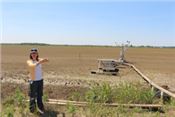|
Financial Assistance Available To Rice Farmers For Conservation Activities

JONESBORO, ARK.
Government officials, NGO representatives, researchers and farmers gathered in a rice field in the Grand Prairie region of Arkansas recently to discuss soil and water conservation, nutrient stewardship, and the USDA’s EQIP (Environment Quality Incentives Program).
Mike Sullivan, State Conservationist for the USDA Natural Resources Conservation Service (NRCS), opened the meeting with a discussion of Secretary of Agriculture Tom Vilsack’s announcement concerning Climate Smart Agriculture and Forestry, a comprehensive set of voluntary programs and initiatives that is expected to reduce net emissions and enhance carbon sequestration by more than 120 million metric tons of CO2 equivalent by 2025 - about two percent of economy-wide emissions.
Sullivan spoke about the availability of $2.5 million for producers to apply for assistance through the Environmental Quality Incentives Program (EQIP). Farmers and landowners in Arkansas have until June 10, 2016, to submit applications to receive financial assistance to implement select conservation activities. Applicants can sign up at their local USDA NRCS field service center. NRCS will prioritize funding applications that address three objectives: improved soil health, nitrogen stewardship, and irrigation water management. The ranking process will consist of a screening tool and ranking questions. The screening tool will be used to make sure the best applications are selected. If all three objectives listed above are addressed, the application will be given high priority; if only two of the objectives are addressed, they will be given medium priority; and low priority if one of the objectives is addressed. Higher priority applications will be considered first. After determining the priority of the applications, the normal ranking procedures will be used to determine funding order.
The objectives are:
• Soil Health – Promoting reduced tillage, reduced compaction, cover crops, and perennial vegetation where appropriate.
• Nitrogen Stewardship – Reduction of nitrous oxide emissions through the use of the “Four R’s” of nitrogen fertilizer management: Right Source, Right Rate, Right Timing, and Right Placement.
• Irrigation Water Management – Irrigation water management along with supporting conservation practices are available through this initiative.
Producer Robby Bevis discussed his efforts at increasing soil health on his farm through cover crops and reduced tillage. Farmer Mark Isbell spoke about his usage of the alternate wetting and drying (AWD) rice irrigation method on his farm, and Dr. Michele Reba discussed her research on greenhouse gas emissions from rice paddies.
John Lee, NRCS State Agronomist, then spoke about the importance of good nitrogen stewardship through cover crops and reduced tillage to aid in building organic matter in soils.
Dr. Reba conducted a tour of her research station set-up in the Isbells’ field and explained the data the sensors are able to gather. ∆
|
|